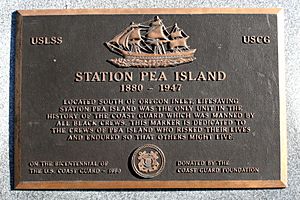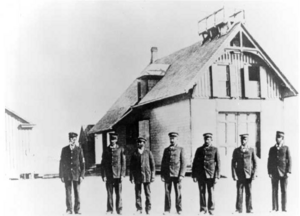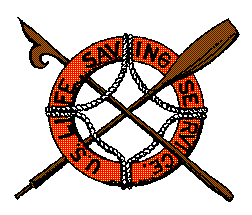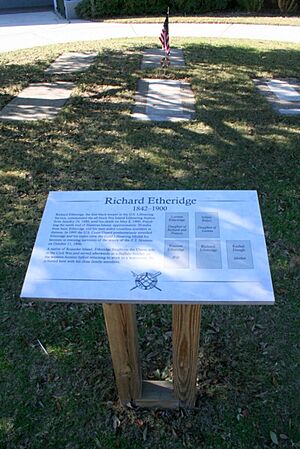Pea Island Life-Saving Station facts for kids
The Pea Island Life-Saving Station was a special rescue station located on Pea Island, along the Outer Banks of North Carolina. It was unique because it was the first life-saving station in the United States to have an all-Black crew. It was also the first in the country to have a Black man, Richard Etheridge, as its leader, known as the keeper. To honor his bravery and leadership, a Coast Guard ship, the USCGC Richard Etheridge (WPC-1102), was named after him in 2012.
Contents
Richard Etheridge: Early Life and Service
Richard Etheridge was born on January 16, 1842, on the Outer Banks of North Carolina. He was born into slavery, belonging to John B. Etheridge. Unlike large farms, there were not many enslaved people on the Outer Banks. From a young age, Richard learned important skills from the sea, like fishing and steering boats. He also learned to read and write, even though it was against the law for enslaved people to do so.
Fighting for Freedom: The Civil War
When the American Civil War began in 1861, the Outer Banks became an important area. In 1862, Union soldiers arrived and started building forts. Many enslaved people found safety there. The Union Army soon began asking Black men to join their forces. Richard Etheridge joined the army on August 28, 1863.
He became a soldier in the 36th United States Colored Troops. This unit played a role in the fight for freedom. They served as guards and took part in some battles. In September 1864, Etheridge's unit showed great bravery during the Battle of Chaffin's Farm in Virginia. Two days after this important victory, Richard Etheridge was promoted to sergeant.
Standing Up for Fairness
Even while fighting in the war, Etheridge worked to stop unfair treatment of Black people. In 1865, he and another soldier, William Benson, wrote a letter to Major General Oliver Otis Howard. They complained about how Black families on Roanoke Island were being treated by soldiers. They wrote that white soldiers were breaking into homes and stealing. Etheridge signed the letter "on behalf of humanity," showing his strong belief in justice.
After the war ended, Etheridge joined units that would later be known as the "Buffalo Soldiers." He left the army in December 1866 and returned to the Outer Banks. He got married and worked as a fisherman. He also joined the new Life-Saving Service.
Becoming a Life-Saving Hero
In the early days, some people got jobs in the Life-Saving Service because of family connections, not always because they were the best at the job. This led to problems, and many lives were lost in shipwrecks off the North Carolina coast. People started to worry that the service was not doing its job well.
A New Leader for Pea Island
In 1879, the Pea Island station had a white leader and a mixed crew of white and Black men. After a failed rescue attempt, the leader was fired. Richard Etheridge, who was known as one of the best surfmen (skilled rescuers) on the North Carolina coast, was chosen to take over.
This was a very important decision. Richard Etheridge was one of only eight African Americans in the entire Life-Saving Service. He was promoted from a lower rank to lead the Pea Island station. The inspector, Lieutenant Charles F. Shoemaker, knew it was unusual to appoint a Black man as a keeper. But he believed Etheridge was the best choice. He described Etheridge as "strong," "intelligent," and able to read and write well. He said Etheridge was "one of the best surfman on this part of the North Carolina coast." He was sure that Etheridge's appointment would make the station much better.
The First All-Black Crew
Richard Etheridge made history as the first African American to be a keeper of a life-saving station. When he was appointed, the white surfmen at Pea Island refused to work under him. Because of this, the Pea Island Station became the only one with an all-Black keeper and crew. All other stations in North Carolina and across the country were led and staffed by white crews.
Just five months after Etheridge took charge, the station building was burned down by arsonists.
The Famous E.S. Newman Rescue

Richard Etheridge knew that he and his crew were being watched closely. Any mistake could lead to them being fired and replaced by a white crew. So, he ran the station like a military unit, with strict training and high standards. All their hard work paid off on the night of October 11, 1896.
A Stormy Night Rescue
A schooner (a type of sailing ship) called the E.S. Newman got stuck south of the station during a terrible hurricane. The captain had his wife and three-year-old son on board. The storm was so bad that Keeper Etheridge had stopped beach patrols.
However, from the station, a surfman named Theodore Meekins thought he saw a distress signal. He fired a Coston flare (a type of signal light) to see if there was a response. Meekins and Etheridge watched carefully, and then they saw the schooner send a flare back.
The Pea Island crew, with the help of a mule team, pulled their rescue equipment and surfboat along the beach. The huge waves made this very difficult. When they reached the wreck, the waves were too strong to launch the surfboat. They also couldn't use a breeches buoy (a rescue device) because the beach was covered by waves.
Heroic Swimmers
Two surfmen bravely volunteered to swim out to the ship in the huge waves. They reached the schooner and managed to throw a rope aboard. Nine times, the surfmen went into the dangerous water. One by one, they rescued everyone from the ship, starting with the captain's three-year-old son. It is said that Theodore Meekins, who was an excellent swimmer, made every trip out to the Newman.
In the days that followed, the Newman's captain found a piece of the ship's side with its name on it. He gave it to the crew as a thank you. For 100 years, this was the only award the Pea Island crew received for their amazing rescue. The crew voted to give the wooden board to Theodore Meekins, who first saw the distress signal and swam out to the wreck many times. Meekins took the board home and nailed it to his barn. He served at Pea Island for 21 more years until he died in 1917.
Later Years and Legacy
Richard Etheridge served as the keeper at Pea Island for twenty years. He became ill and died at the station in January 1900, at the age of 58. The Pea Island station continued to have an all-Black crew until it was closed in 1947.
In 1996, the Coast Guard finally honored the keeper and crew of the Pea Island station. They were given the Gold Life-Saving Medal for their heroic rescue of the people from the E.S. Newman. This award was given many years after the rescue. Richard Etheridge and his family are buried at a memorial near the North Carolina Aquarium on Roanoke Island.
Honoring a Hero
In 2010, the town of Manteo put up a bronze statue to honor Richard Etheridge.
The Coast Guard also named a ship, the USCGC Richard Etheridge, after him. It was officially put into service on August 3, 2012.
In 2021, the Coast Guard Bears football team, representing the United States Coast Guard Academy, dedicated their season's uniforms to the Pea Island Life-Saving Station 17.
Richard Etheridge is also the main character in a historical novel called Black Cloud Rising (2022) by David Wright Faladé. The book tells his story from when he joined the army to his time at the Pea Island Life-Saving Station.




